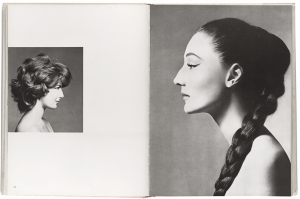A note…
This month’s book ‘Observations’ is not easily accessible in your local library, nor is it affordable to most. But we consider it to be more than worthy of a Photo Book Club discussion, and so next week we will post a video looking through the book, making sure this incredible book is available to view by as many fans as possible!
Title
Observations
Author
Richard Avedon, with comments by Truman Capote
Publisher
Simon & Schuster, 1959

Overview
Like Robert Frank’s ‘The Americans,’ which we discussed last month in the Photo Book Club, American photographer Richard Avedon’s first book, ‘Observations,’ was published in 1959. And, like ‘The Americans’ it was included in Andrew Roth’s ‘The Book of 101 Books: Seminal Photographic Books of the 20th Century (PPP Editions, 2001), now itself a seminal work on the history of the photographic book.
Having begun to take photographs during the Second World War, where he served in the Merchant Marine, Avedon became chief photographer of ‘Harper’s Bazaar’ in the late 1940s, where he helped redefine and elevate fashion photography to an art form, frequently taking his models out of the studio.
But Avedon’s first book did not focus on his fashion work, but on his iconic and penetrating portraits. In the 150 pages that form ‘Observations,’ with comments by the great American writer Truman Capote, we encounter the likes of Charlie Chaplin, John Huston, Alfred Hitchcock, The Duke and Duchess of Windsor, Arthur Miller, Pablo Picasso, Marilyn Monroe, Mae West, Judy Garland, Igor Stravinsky, Katherine Hepburn, Brigitte Bardot, Louis Armstrong, Humphrey Bogart, Buster Keaton, and many others.
Reflecting upon Avedon’s oeuvre, Maria Morris Hambourg recently wrote ‘By dint of progressive challenges to himself, Richard Avedon has not only distilled photographic portraiture to its irreducible core, but has also produced an extended meditation on life, death, art, and identity. Laureate of the invisible reflected in physiognomy, Avedon has become our poet of portraiture.’
Wayne Ford
Get involved
Let us know your thoughts by using the hashtag #photobc in Twitter or share links and blog posts in to comment section below.
Coming next…
Next week we will post a video, showing the book in all it’s glory to those who do not own, or have access to a copy (which is most of us!)
5 replies on “Synopsis: Richard Avedon – Observations (With comments by Truman Capote)”
Ok, I’ll start:
I own a battered copy of Observations, but had not looked at it in a couple of years. So, coming to it with fresh eyes, I think the first thing about the book, which we mostly take for granted, with our contemporary sensibility, is its very magazine-like architecture.
Viewing Observations from 2011, it’s hard to see how provocative it must have been to try to synthesize pop culture and high culture in a formal publication like a book, and in the way that Avedon and Alexey Brodovitch attempted here. Unlike a whole, unified, complete book, we have the joining of a number of not obviously related chapters, like magazine features: The Actors, The Singers, The Swans, The Couples, and so on. And then we have an even greater stylistic and thematic jump to Italy popped into the middle of this book.
I don’t find the approach completely satisfying or successful. By comparison, I much prefer later Avedon books where he pursued a consistent formal approach, including the American West and Richard Avedon Portraits. These are the books where Avedon most clearly and successfully gives us what I want from him: the sense of confrontation that defined his white background portraiture.
Another important formal element that we see in Observations is the development of Avedon’s strategies of montage: his use of two images on facing pages to make implied claims of similarity or difference between the people pictured. Again, it seems obvious to our 21st-century media-saturated eyes that we should do this as photographic designers, but look for comparison at the techniques of sequencing and montage in The Americans.
Avedon’s pictures speak to each other and create higher orders of metaphorical meaning in a way distinct from Frank’s sequencing. Consider, for example, page 146, where Avedon joins photographs of Robert Oppenheimer and Martin Darcy in a similar stance, and that helps to inspire Capote’s analysis of appearance and virtue.
[…] Skip to content HomeReading ListGet InvolvedAboutContact ← Synopsis: Richard Avedon – Observations (With comments by Truman Capote) […]
[…] Synopsis […]
Hi, I’ve just stumbled across your site, although I fear that I might be a little late in finding it due to a lack of current info. I’m a lifelong photographer who is currently working through my back catalogue. Sometimes I turn the photos in to photo books. I notice that with books such as The Americans, Richard Avendon etc listed you’re talking about historical works. I have volumes by both the mentioned photographers. Is the club still in existence. Is it possible to share our own creations in PDF format through the site?
Hi Roy,
The site and project is still very much going though we no longer look at these historical works online. Instead, communities of readers meet around the world to share thoughts on books. It is worth mentioning that the emphasis of this project is not on sharing our own work — but you will find plenty of spaces in which to do this.
Matt